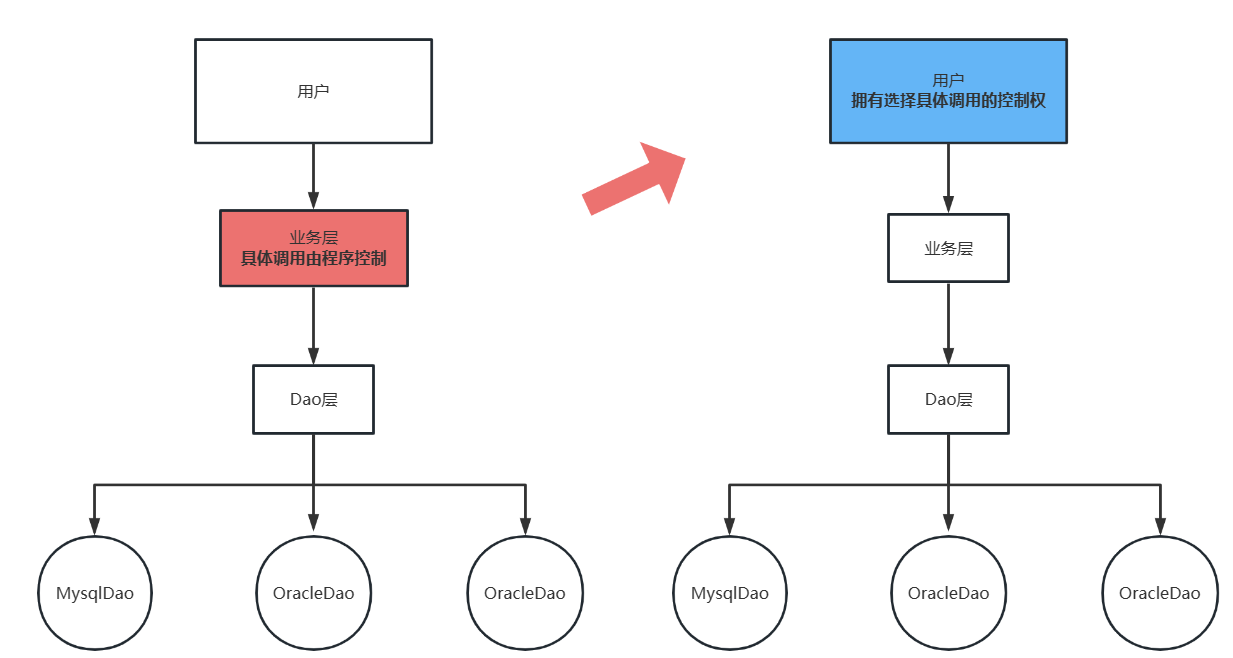Spring5
简介
Spring的理念:使现有的技术更加容易使用,本身是一个大杂烩,整合了现有的技术框架。
- Spring是一个开源的免费框架
- Spring是一个轻量级的、非侵入式的框架
- 重要特性:IoC(控制反转)、AOP(面向切面编程)
- 支持事务的处理。支持整合框架
IoC理论
控制反转(IoC,Inversion of Control)是一种思想,由主动地编程转变为被动地接收。
传统的方式使用面向对象编程,对象的创建与对象间的依赖关系完全硬编码在程序中,由程序自己控制:
1 | public class UserServiceImpl implements UserService { |
利用set实现 动态值的注入,将获取依赖对象的控制权从程序本身交给用户。大大降低了系统的耦合性,可以更加专注在业务的实现上。
1 | public class UserServiceImpl implements UserService { |

IoC本质
控制反转是一种通过描述(XML或注解)并通过第三方去生产或获取特定对象的方式。在Spring中,实现控制反转的是IoC容器,其实现方法是依赖注入(DI,Dependency Injection)。
控制:传统应用程序的对象由程序本身控制创建,使用Spring后,对象由Spring来创建。
反转:程序本身不创建对象,变成了被动地接收对象。
依赖:bean对象的创建依赖于容器
注入:bean对象中的所有属性,由容器来注入
IoC创建对象的方式
导包
1 | <dependencies> |
默认使用无参构造创建对象
1 | <!-- 无参构造 --> |
使用有参构造创建对象
1 | <!-- 有参构造函数,根据下标赋值 --> |
在Bean默认的作用域Singleton(单例)模式下,配置文件加载的时候,容器中管理的所有对象就已经完成了初始化。后续getBean的操作直接获取对象。
1 |
|
Spring配置
别名
1 | <!-- name的值为别的bean的id,如果添加了别名,也可以使用别名获取到这个对象 --> |
Bean的配置
1 | <!-- 使用Spring来创建对象,在Spring中,这些对象称为bean |
import
import一般用于团队开发使用,可以将多个配置文件,导入合并成一个。
1 | <beans ...> |
DI 依赖注入
- 依赖:bean对象的创建依赖于容器
- 注入:bean对象中的所有属性,由容器来注入
构造器注入
Set方式注入
复杂类型
1
2
3
4
5
6
7
8
9
10
11
12
13
14
15
16
17
18
19
20
21
22
23
24
25
26
27
28
29
30
31
32
33
34
35
36
37
38
39
40
41
42
43
44
45
46public class Address {
private String address;
public String getAddress() {
return address;
}
public void setAddress(String address) {
this.address = address;
}
}
// =============================================================================
public class Student {
private String name;
private boolean isMale;
private Address address;
private String[] books;
private List<String> hobbies;
private Map<String, String> cards;
private Set<String> games;
private Properties info;
//...
public String toString() {
return "Student{" +
"name='" + name + '\'' +
", isMale=" + isMale +
", address=" + address +
", books=" + Arrays.toString(books) +
", hobbies=" + hobbies +
", cards=" + cards +
", games=" + games +
", info=" + info +
'}';
}
}beans.xml
1
2
3
4<bean id="student" class="com.hunter.pojo.Student">
<!-- 普通值注入,使用value -->
<property name="name" value="黄铁"/>
</bean>完善注入信息
1
2
3
4
5
6
7
8
9
10
11
12
13
14
15
16
17
18
19
20
21
22
23
24
25
26
27
28
29
30
31
32
33
34
35
36
37
38
39
40
41
42
43
44
45
46
47
48
49
50<bean id="student" class="com.hunter.pojo.Student">
<!-- 注入普通值,使用value -->
<property name="name" value="黄铁"/>
<!-- 注入bean,使用ref -->
<property name="address" ref="address"/>
<!-- 注入数组,使用array -->
<property name="books">
<array>
<value>银河帝国</value>
<value>灌篮高手</value>
</array>
</property>
<!-- 注入List,使用list -->
<property name="hobbies">
<list>
<value>电影</value>
<value>篮球</value>
</list>
</property>
<!-- 注入Map,使用map -->
<property name="cards">
<map>
<entry key="身份证" value="3303000000000000000"/>
<entry key="校园卡" value="3002092000002033"/>
</map>
</property>
<!-- 注入Set,使用set -->
<property name="games">
<set>
<value>麻将</value>
<value>斗地主</value>
</set>
</property>
<!-- 注入null -->
<property name="girlFriend">
<null/>
</property>
<!-- 注入Properties -->
<property name="info">
<props>
<prop key="driver">com.mysql.cj.jdbc.Driver</prop>
<prop key="jdbc">jdbc:mysql://localhost:3306/mybatis?useSSL=true&useUnicode=true&characterEncoding=UTF-8</prop>
</props>
</property>
</bean>
<bean id="address" class="com.hunter.pojo.Address"/>
扩展方式
可以使用p命令空间和c命名空间进行注入。
1 | <beans xmlns="http://www.springframework.org/schema/beans" |
Bean的作用域
| Scope | 描述 |
|---|---|
| singleton 单例模式 |
(默认) 每次从容器中getBean的时候,都会取相同的一个对象。 |
| prototype 原型模式 |
每次从容器中getBean的时候,都会产生一个新对象。 |
| request | 只在web开发中使用 Scopes a single bean definition to the lifecycle of a single HTTP request. That is, each HTTP request has its own instance of a bean created off the back of a single bean definition. Only valid in the context of a web-aware Spring ApplicationContext. |
| session | 只在web开发中使用 Scopes a single bean definition to the lifecycle of an HTTP Session. Only valid in the context of a web-aware Spring ApplicationContext. |
| application | 只在web开发中使用 Scopes a single bean definition to the lifecycle of a ServletContext. Only valid in the context of a web-aware Spring ApplicationContext. |
| websocket | 只在web开发中使用 Scopes a single bean definition to the lifecycle of a WebSocket. Only valid in the context of a web-aware Spring ApplicationContext. |